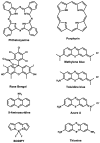Antimicrobial Photodynamic Therapy: Self-Disinfecting Surfaces for Controlling Microbial Infections
- PMID: 39203415
- PMCID: PMC11356738
- DOI: 10.3390/microorganisms12081573
Antimicrobial Photodynamic Therapy: Self-Disinfecting Surfaces for Controlling Microbial Infections
Abstract
Microbial infections caused by bacteria, viruses, and fungi pose significant global health threats in diverse environments. While conventional disinfection methods are effective, their reliance on frequent chemical applications raises concerns about resistance and environmental impact. Photodynamic self-disinfecting surfaces have emerged as a promising alternative. These surfaces incorporate photosensitizers that, when exposed to light, produce reactive oxygen species to target and eliminate microbial pathogens. This review explores the concept and mechanism of photodynamic self-disinfecting surfaces, highlighting the variety and characteristics of photosensitizers integrated into surfaces and the range of light sources used across different applications. It also highlights the effectiveness of these surfaces against a broad spectrum of pathogens, including bacteria, viruses, and fungi, while also discussing their potential for providing continuous antimicrobial protection without frequent reapplication. Additionally, the review addresses both the advantages and limitations associated with photodynamic self-disinfecting surfaces and concludes with future perspectives on advancing this technology to meet ongoing challenges in infection control.
Keywords: microbial; pathogen; photosensitizers; public health; self-disinfecting.
Conflict of interest statement
The author declares no conflicts of interest.
Figures
Similar articles
-
Self-Disinfecting Copper Beds Sustain Terminal Cleaning and Disinfection Effects throughout Patient Care.Appl Environ Microbiol. 2019 Dec 13;86(1):e01886-19. doi: 10.1128/AEM.01886-19. Print 2019 Dec 13. Appl Environ Microbiol. 2019. PMID: 31704675 Free PMC article.
-
Natural Photosensitizers in Antimicrobial Photodynamic Therapy.Biomedicines. 2021 May 21;9(6):584. doi: 10.3390/biomedicines9060584. Biomedicines. 2021. PMID: 34063973 Free PMC article. Review.
-
Self-Disinfecting Urethral Catheter to Overcome Urinary Infections: From Antimicrobial Photodynamic Action to Antibacterial Biochemical Entities.Microorganisms. 2022 Dec 15;10(12):2484. doi: 10.3390/microorganisms10122484. Microorganisms. 2022. PMID: 36557737 Free PMC article. Review.
-
Self-disinfecting surfaces and activity against Staphyloccocus aureus ATCC 6538 under real-life conditions.J Hosp Infect. 2017 Oct;97(2):196-199. doi: 10.1016/j.jhin.2017.06.022. Epub 2017 Jun 22. J Hosp Infect. 2017. PMID: 28647424
-
Light-activated antimicrobial coatings: the great potential of organic photosensitizers.RSC Adv. 2025 Mar 13;15(10):7905-7925. doi: 10.1039/d5ra00272a. eCollection 2025 Mar 6. RSC Adv. 2025. PMID: 40084300 Free PMC article. Review.
Cited by
-
3D-printed surface coated with natural photosensitizer for photodynamic inactivation of methicillin-resistant Staphylococcus aureus using visible light.Lasers Med Sci. 2025 Feb 24;40(1):115. doi: 10.1007/s10103-025-04378-y. Lasers Med Sci. 2025. PMID: 39988576
-
Optimizing of photodynamic parameters: determining the key factors for effective inactivation of Streptococcus mutans biofilms with phycocyanin.Lasers Med Sci. 2025 May 13;40(1):224. doi: 10.1007/s10103-025-04479-8. Lasers Med Sci. 2025. PMID: 40358765
-
Biofilm Resilience: Molecular Mechanisms Driving Antibiotic Resistance in Clinical Contexts.Biology (Basel). 2025 Feb 6;14(2):165. doi: 10.3390/biology14020165. Biology (Basel). 2025. PMID: 40001933 Free PMC article. Review.
References
-
- Hari S. Public Health: A Global Perspective. CRC Press; Boca Raton, FL, USA: 2024. Emerging Diseases; pp. 279–284. - DOI
-
- Paul J. Disease Causing Microbes. Springer; Cham, Switzerland: 2024. Introduction to Infectious Diseases. - DOI
-
- Hui H., Bo W., Qi Z., Yueqian S. Summary of global surveillance data of infectious diseases in February 2024. Dis. Surveill. 2024;39:258–260. doi: 10.3784/jbjc.202103220141. - DOI
-
- Kchaou M., Abuhasel K., Khadr M., Hosni F., Alquraish M. Surface disinfection to protect against microorganisms: Overview of traditional methods and issues of emergent nanotechnologies. Appl. Sci. 2020;10:6040. doi: 10.3390/app10176040. - DOI
Publication types
LinkOut - more resources
Full Text Sources




